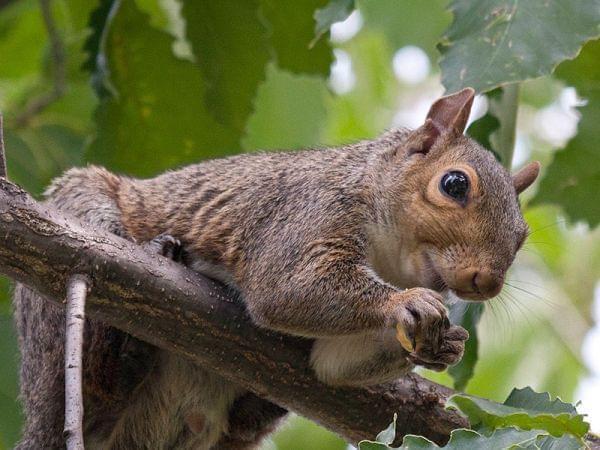An Ecological Look at Acorns

Gray squirrel eating an acorn in a Chinkapin oak Rob Kanter
Last week I found a walnut on my windowsill, a big fat one with an unblemished bright green husk. Soon after, another appeared stuck in the wheel of my car. Now they’re cached everywhere around the outside of our house, from the shelf on the grill to the flowerpots on the deck.
Acorns are everywhere now, too, as anyone who bicycles where there are oaks can attest. A person’s got to keep both hands on the handlebars to avoid having them wrenched sideways.
While these seeds may present me with minor annoyances, they’re much more interesting and important from an ecological perspective.
Scientists group walnuts and acorns together with hickory nuts and beechnuts in the category of hard mast. This they distinguish from soft mast, which generally refers to fruits like crabapples and blueberries but can also apply to other parts of plants that serve as food for wildlife.
According to Ed Heske, a mammal ecologist with the Illinois Natural History Survey at the U of I Prairie Research Institute, “The most important thing about hard mast from the perspective of wild animals is that it’s storable. Without hard mast many mammals that don’t hibernate in winter would have little to eat.”
Of course, while it’s a good thing for squirrels that acorns can be stored for eating over the winter, it is not in the interest of oak trees to expend all of the resources needed to produce such wonderful seeds if all of them wind up as squirrel food.
Evolution has provided oaks with a clever reproductive strategy to avert that outcome, referred to as masting cycles.
In most years, oaks produce a sort of baseline quantity of acorns, and populations of animals that depend on them become calibrated to that. But every few years or so, depending on weather and other factors, the oaks of a local area synchronize their energy and produce a bumper crop—up to a hundred times the baseline quantity of seeds in some species. With populations of acorn eaters limited by the leaner years, chances are that some portion of acorns from the bumper crop will go uneaten and grow into the next generation of oaks.
There is another wrinkle to this story, though. Some years back Heske and a colleague conducted a study that found acorns would result in new oak seedlings only if some of them were buried by squirrels and then never recovered, a situation expected primarily when acorns are superabundant in mast years. Otherwise something—whether it was a deer, turkey, mouse or weevil—always ate them up from the soil surface before they had a chance to germinate.
In addition to promoting new generations of oaks, Heske explained to me, bumper crops of acorns initiate a cascade of other ecosystem effects. Extra acorns, for example, enable forest-dwelling mice to reproduce especially well; during mast years they can add an extra litter or two, and add to the size of their litters as well.
Good for the mice, right?
But what’s good for mice is, in turn, good for great horned owls and the other predators that eat mice. They generally experience a bump in reproductive success in the year following a mast year.

